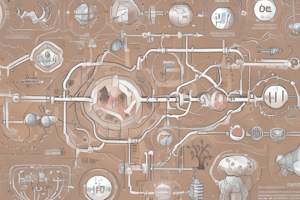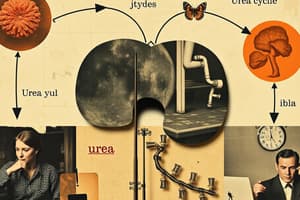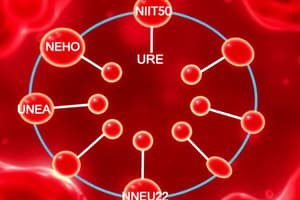Podcast
Questions and Answers
What is the primary function of Carbonyl Phosphate Synthetase 1 (CPS 1)?
What is the primary function of Carbonyl Phosphate Synthetase 1 (CPS 1)?
- Converts ammonium to carbonyl phosphate (correct)
- Synthesizes urea from nitrogen
- Converts carbamyl phosphate to citrulline
- Catalyzes the formation of arginine
Citrulline is an amino acid found in proteins.
Citrulline is an amino acid found in proteins.
False (B)
Which compound is important in the urea cycle?
Which compound is important in the urea cycle?
N-Acetylglutamate
The urea cycle eliminates excess nitrogen in the form of ______.
The urea cycle eliminates excess nitrogen in the form of ______.
Where is Arginosuccinate Synthetase located?
Where is Arginosuccinate Synthetase located?
Both citrulline and ornithine can cross the mitochondrial membrane.
Both citrulline and ornithine can cross the mitochondrial membrane.
What is the primary function of arginosuccinate synthetase?
What is the primary function of arginosuccinate synthetase?
Name the enzyme that converts ornithine and carbamyl phosphate to citrulline.
Name the enzyme that converts ornithine and carbamyl phosphate to citrulline.
Match the following enzymes with their locations in the urea cycle:
Match the following enzymes with their locations in the urea cycle:
Arginase breaks down arginosuccinate to form urea.
Arginase breaks down arginosuccinate to form urea.
What condition is characterized by elevated levels of ammonia in the blood?
What condition is characterized by elevated levels of ammonia in the blood?
The urea cycle is activated by the flow of ______.
The urea cycle is activated by the flow of ______.
Match each enzyme with its function:
Match each enzyme with its function:
What is a urea precursor?
What is a urea precursor?
High concentrations of citrulline are a result of argininosuccinate synthetase deficiency.
High concentrations of citrulline are a result of argininosuccinate synthetase deficiency.
Name one effect of arginase deficiency.
Name one effect of arginase deficiency.
What is the primary role of glutaminase in nitrogen metabolism?
What is the primary role of glutaminase in nitrogen metabolism?
The ammonium ion is more toxic than ammonia.
The ammonium ion is more toxic than ammonia.
What substance is used to capture protons in the L-Amino Acid Oxidase reaction?
What substance is used to capture protons in the L-Amino Acid Oxidase reaction?
The breakdown of D-amino acids occurs in the ______.
The breakdown of D-amino acids occurs in the ______.
Match the following enzymes with their primary function:
Match the following enzymes with their primary function:
What happens in a complete block of the urea cycle?
What happens in a complete block of the urea cycle?
Alanine is transported to muscle cells for energy during the Glucose-Alanine Cycle.
Alanine is transported to muscle cells for energy during the Glucose-Alanine Cycle.
What is the toxic threshold for ammonia levels in micrograms per liter?
What is the toxic threshold for ammonia levels in micrograms per liter?
What is carbamylphosphate primarily used for?
What is carbamylphosphate primarily used for?
Orotic acid is NOT an intermediate in the pyrimidine biosynthesis pathway.
Orotic acid is NOT an intermediate in the pyrimidine biosynthesis pathway.
What condition shows elevated levels of orotic acid while ammonia levels remain normal?
What condition shows elevated levels of orotic acid while ammonia levels remain normal?
In the case of OTC deficiency, ammonia levels are _____ and BUN levels are _____ .
In the case of OTC deficiency, ammonia levels are _____ and BUN levels are _____ .
Match the condition with its respective ammonia and orotic acid levels:
Match the condition with its respective ammonia and orotic acid levels:
Which enzyme catalyzes the production of carbamylphosphate from ammonia and bicarbonate?
Which enzyme catalyzes the production of carbamylphosphate from ammonia and bicarbonate?
Elevated orotic acid levels are a diagnosis indicator for Carbamylphosphate Synthetase 1 (CPS 1) deficiency.
Elevated orotic acid levels are a diagnosis indicator for Carbamylphosphate Synthetase 1 (CPS 1) deficiency.
What is the main clinical sign associated with urea cycle disorders?
What is the main clinical sign associated with urea cycle disorders?
The enzyme __________ converts citrulline to argininosuccinate.
The enzyme __________ converts citrulline to argininosuccinate.
Match the enzyme deficiencies with their corresponding clinical features:
Match the enzyme deficiencies with their corresponding clinical features:
Which of the following clinical signs is NOT associated with elevated ammonia levels?
Which of the following clinical signs is NOT associated with elevated ammonia levels?
Decreased Blood Urea Nitrogen (BUN) levels can indicate a problem with the urea cycle.
Decreased Blood Urea Nitrogen (BUN) levels can indicate a problem with the urea cycle.
Pyrimidine biosynthesis is essential for the synthesis of __________ and __________.
Pyrimidine biosynthesis is essential for the synthesis of __________ and __________.
Flashcards are hidden until you start studying
Study Notes
Urea Cycle
- The Urea Cycle is a series of chemical reactions that take place in the liver and kidneys. It detoxifies ammonia - a toxic byproduct of protein metabolism
- The Urea Cycle is split between the mitochondrion and the cytosol
- The Urea Cycle is activated by the flow of nitrogen
- The Urea Cycle involves five key enzymes:
- Carbamyl Phosphate Synthetase 1 (CPS 1): found in the mitochondrial matrix
- Ornithine Transcarbamylase (OTCPSase): found in the mitochondrial matrix
- Arginosuccinate Synthetase: found in the cytosol
- Arginosuccinate Lyase: found in the cytosol
- Arginase: found in the cytosol
Urea Cycle Enzymes
- Arginosuccinate Synthetase takes citrulline and aspartate to form arginosuccinate.
- Arginosuccinate Lyase breaks down arginosuccinate to form arginine and fumarate.
- Arginase takes arginine and breaks it down to form urea, the primary product of nitrogen excretion.
- **Carbamyl Phosphate Synthetase 1 (CPS 1) ** Takes bicarbonate and ammonium ion to form carbonyl phosphate with a nitrogen.
- **Ornithine Transcarbamylase (OTC) ** Takes ornithine and carbamyl phosphate to form citrulline.
Urea Cycle Precursors
- Aspartate: a urea precursor
- Free Ammonium Ion: a urea precursor
- Carbamyl Phosphate: a urea precursor
Hyperammonemia
- Hyperammonemia is characterized by elevated levels of ammonia (NH₃) in the blood.
- Hyperammonemia is a serious condition that can lead to brain damage and death.
- Hyperammonemia can result from deficiencies in various enzymes involved in the urea cycle.
- **Alpha-Ketoglutarate ** can be used to transaminate nitrogen to glutamate - an intracellular carrier of nitrogen.
Urea Cycle Deficiencies
- Argininosuccinate Synthetase deficiency results in high concentrations of citrulline.
- Arginase deficiency results in low concentrations of ornithine.
- A complete block in the urea cycle is incompatible with life.
- Complete block in the urea cycle leads to hyperammonemia and ammonia intoxication.
- Patients with a complete block in the urea cycle may be intolerant to protein ingestion and may show mental and CNS deficiencies.
Ornithine Transcarbamylase (OTC) Deficiency
- Ornithine Transcarbamylase (OTC) deficiency results in elevated carbamylphosphate levels in the mitochondria.
- Carbamylphosphate can cross the inner mitochondrial membrane and enter the cytosol
- OTC deficiency artificially stimulates pyrimidine biosynthesis, resulting in increased orotic acid production.
- OTC deficiency is characterized by elevated ammonia levels, decreased BUN, and elevated orotic acid levels.
Carbamylphosphate Synthetase 1 (CPS 1) Deficiency
- Carbamylphosphate Synthetase 1 (CPS 1) deficiency results in decreased carbamylphosphate levels.
- CPS 1 deficiency does not lead to artificial stimulation of pyrimidine biosynthesis.
- CPS 1 deficiency is characterized by elevated ammonia levels, decreased BUN, and no orotic acid.
Clinical Signs and Symptoms of Hyperammonemia
- Elevated ammonia levels
- Decreased BUN (Blood Urea Nitrogen)
- Increased blood glutamine levels
- Central edema, lethargy, convulsions, coma, and death
Pyrimidine Biosynthesis
- Pyrimidine biosynthesis is the process of producing pyrimidine nucleotides which are essential for DNA and RNA synthesis.
- Carbamylphosphate is a key compound that is used in pyrimidine biosynthesis.
- Orotic acid is an intermediate compound in the pyrimidine biosynthesis pathway.
- Deficiencies in pyrimidine biosynthesis can also result in elevated orotic acid levels.
Differential Diagnosis
- OTC Deficiency is characterized by elevated ammonia levels, decreased BUN, and elevated orotic acid levels.
- CPS 1 Deficiency is characterized by elevated ammonia levels, decreased BUN, and no orotic acid.
- Pyrimidine Biosynthesis Deficiency is characterized by normal ammonia levels, normal BUN, and elevated orotic acid levels.
Amino Acid Metabolism
- Glutaminase removes nitrogen and generates glutamate and glutamine, an intracellular carrier of nitrogen.
- Glutamine Synthetase is mentioned earlier in the lecture.
- Asparaginase is not significant in terms of enzyme issues.
- L-Amino Acid Oxidase is a deamination reaction that generates α-keto acid and ammonium. It requires FMN to capture protons and generates peroxide.
- D-Amino Acid Oxidase breaks down D-amino acids, commonly found in bacterial infections. It generates peroxide and occurs in the peroxisome where catalase detoxifies the peroxide.
Toxicity of Ammonia
- Ammonia levels greater than 10 micrograms per liter are toxic to cells.
- Ammonium ion is less toxic than ammonia, with a concentration of about half a milligram.
The Glucose-Alanine Cycle (Cahill Cycle)
- Alanine is converted to pyruvate, then to glucose in the liver.
- Glucose is transported to the brain and red blood cells, not the muscle cells.
- Muscle cells use fatty acids and ketone bodies for energy.
Urine and Ammonia
- Urine is acidic and traps ammonia as the ammonium ion, decreasing the toxicity of ammonia.
- Ammonia is more toxic than the ammonium ion.
Citrulline and Ornithine
- Citrulline is an amino acid not found in proteins, used in the urea cycle.
- Ornithine is an amino acid not found in proteins, used in the urea cycle.
- Both Citrulline and Ornithine can cross the mitochondrial membrane.
Studying That Suits You
Use AI to generate personalized quizzes and flashcards to suit your learning preferences.



